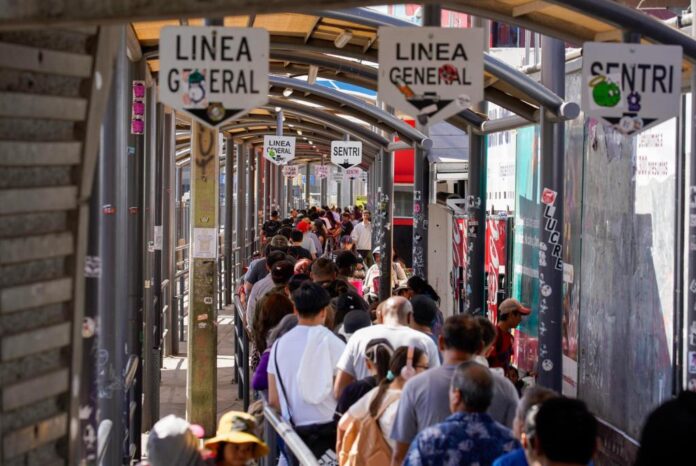
In 2021, it was announced that the Tijuana-San Diego region was going to have a fourth port of entry for international travelers, joining San Ysidro and Otay Mesa for pedestrians and vehicles, and the Cross Border Xpress for those traveling into or from Tijuana’s airport. The Otay Mesa East Port of Entry, with a new and faster paying-to-cross-the-border system, was expected to began operating by 2024, but last year the project got delayed until 2026. And recently, it was reported that the new border crossing might be ready by 2028.
Meanwhile, the line of cars and pedestrians grows for miles every morning in Tijuana. It doesn’t matter if it’s a Tuesday or a Saturday, in May or in December. Two of the three lines of la Vía Rápida, one of Tijuana’s main highway, are usually jammed with cars waiting for hours to cross to San Ysidro. The pedestrians, old and young, wait under the sun, or the rain. Some are carrying books in backpacks, others laptops in briefcases; all are there for a valid reason.
In different stages of my life, I have been a cross-border commuter. It started way back in the early ‘90s, when my mother would drive me every weekday from Tijuana to Imperial Beach to take classes at Bayside Elementary School.
From a very young age, I got used to waking up early, leaving home and crossing the border in the cold or in the heat, with a storm or nice weather, eating breakfast and lunch at school, paying attention to my classes, playing with my friends, waiting for mom to come pick me up, then returning to Tijuana and doing it all over again the following day.
I still remember the episode that made my mother change her mind and stop taking me to school in San Diego. It was partially because an immigration agent made her feel uncomfortable, asking us many questions and trying to understand how it was possible that a Mexican mother with a tourist visa had a car and could cross the border almost every day to take her American-citizen daughter to school. He threatened to take her documents away.
“Háblale a mi esposo” — talk to my husband — my mother told the agent, knowing that she wasn’t doing anything wrong. The immigration agent then questioned me, a 6-year-old girl: “Where were you born?” “How old are you?” “Is this your mother?”
Aside from that episode, I still believe that it was because of that early education in English that I was able to grow up bilingual. I didn’t know back then, but it was a big sacrifice my parents made and one that eventually opened doors and allowed me to become a contributing member of my country.
As a transfronteriza, I witnessed how the border security morphed after 9/11, and how the long lines became the new normal for tourists, students and workers waiting to cross, walking or inside of a car.
Once I had a professional degree and decided that I wanted to work on the northern side of the border, I joined the group of commuters, once again. This time it was my decision and, ultimately, I truly understand why many others do it: to pursue a better life.
Constantly, in social media, I see comments trying to degrade those that choose the transfronterizo life. “Is it worth it?” some might ask. I can say it is. 45,000 binational students in California and Mexico and their parents think so. The 54,000 workers who cross the border from Baja California to go to their jobs in California every day think so. And there’s nothing wrong about it. It’s our right.
One day, when I was younger and on my own trying to cross the border, I had to face the incredulous border agents, just like my mom did. My first driver’s license and my first car’s plates were issued by a Mexican state, Baja California. On my way to San Ysidro, the immigration agent asked “Why are you driving a car with Mexican plates?” I replied, explaining I lived in Mexico with my parents who are Mexican. “Well, at least you speak English,” he said.
Navarro is community opinion editor at The San Diego Union-Tribune. She is a transfronteriza who lives on both sides of the border.
Originally Published:



